
Hornbeams are hardwood trees in the plant genus Carpinus in the family Betulaceae. The 30–40 species occur across much of the temperate regions of the Northern Hemisphere.

Aralia elata, also known as the Japanese angelica tree, Chinese angelica-tree, or Korean angelica-tree, is a species of woody plant in the family Araliaceae.

Forsythia, is a genus of flowering plants in the olive family Oleaceae. There are about 11 species, mostly native to eastern Asia, but one native to southeastern Europe. Forsythia – also one of the plant's common names – is named after William Forsyth.

Platycladus is a monotypic genus of evergreen coniferous trees in the cypress family Cupressaceae, containing only one species, Platycladus orientalis, also known as Chinese thuja, Oriental arborvitae, Chinese arborvitae, biota or Oriental thuja. It is native to northeastern parts of East Asia and North Asia, but is also now naturalised as an introduced species in other regions of the Asian continent.

Lonicera japonica, known as Japanese honeysuckle and golden-and-silver honeysuckle, is a species of honeysuckle native to East Asia, including many parts of China. It is often grown as an ornamental plant, but has become an invasive species in a number of countries. Japanese honeysuckle is used in traditional Chinese medicine.
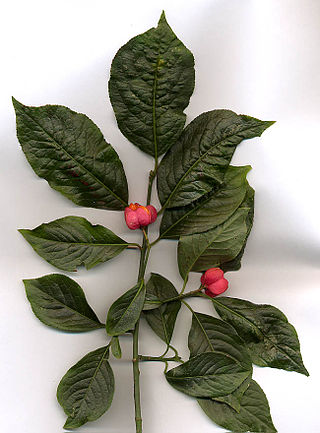
Euonymus is a genus of flowering plants in the staff vine family, Celastraceae. Common names vary widely among different species and between different English-speaking countries, but include spindle, burning-bush, strawberry-bush, wahoo, wintercreeper, or simply euonymus. It comprises about 130 species of deciduous and evergreen shrubs, small trees and lianas. They are mostly native to East Asia, extending to the Himalayas, and they are also distributed in Europe, Australasia, North America, and Madagascar. 50 species are endemic to China.

Pinus densiflora, also called the Japanese red pine, the Japanese pine, or Korean red pine, is a species of pine tree native to East Asia. In China it is known as 赤松.

Phalaris arundinacea, or reed canary grass, is a tall, perennial bunchgrass that commonly forms extensive single-species stands along the margins of lakes and streams and in wet open areas, with a wide distribution in Europe, Asia, northern Africa and North America. Other common names for the plant include gardener's-garters and ribbon grass in English, alpiste roseau in French, Rohrglanzgras in German, kusa-yoshi in Japanese, caniço-malhado in Portuguese, and hierba cinta and pasto cinto in Spanish.
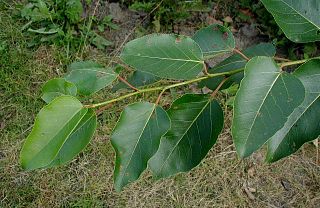
The balsam poplars are a group of about 10 species of poplars, indigenous to North America and eastern Asia, distinguished by the balsam scent of their buds, the whitish undersides of their leaves, and the leaf petiole being round in cross-section. They are large deciduous trees, 30–60 m tall, with leaves with a rounded base, pointed apex, and a whitish waxy coating on the underside of the leaf; this latter distinguishes them from most other poplars. The name is derived from the pleasant balsam smell of the opening buds and leaves in spring, produced by a sticky gum on the buds which also helps protect the buds from insect damage. The balsam poplars are light-demanding trees that require considerable moisture. Balsam poplars are tolerant of very cold conditions, occurring further north than other poplars except for the aspens. The poplars in Southern California are tolerant of 100 plus degree heat. They grow along dry washes and dry riverbed's. The dry washes and dry riverbeds will have flowing water when it rains sufficiently. Their leaves hang down and are at an edge to the sun. This may be another factor why they can take the high heat. Their leaves tremble in the slightest breeze like the quaking aspen
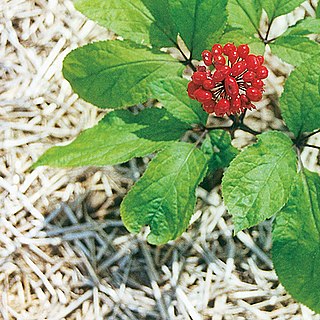
Panax ginseng, ginseng, also known as Asian ginseng, Chinese ginseng or Korean ginseng, is a species of plant whose root is the original source of ginseng. It is a perennial plant that grows in the mountains of East Asia.

Camphora officinarum is a species of evergreen tree that is commonly known under the names camphor tree, camphorwood or camphor laurel.

Platycodon grandiflorus is a species of herbaceous flowering perennial plant of the family Campanulaceae, and the only member of the genus Platycodon. It is native to East Asia. It is commonly known as balloon flower, Chinese bellflower, or platycodon.
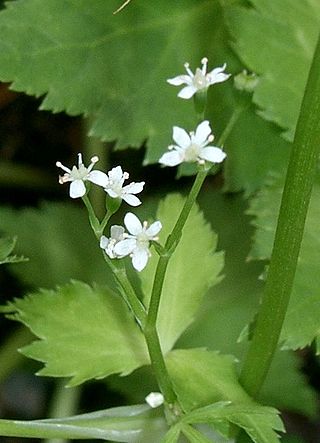
Cryptotaenia japonica, also called East Asian wildparsley, Japanese cryptotaenia, Japanese honewort, white chervilmitsuba, Japanese wild parsley, stone parsley, honeywort, san ip, trefoil, and san ye qin is a plant species native to Japan, Korea, and China. The plant is edible and is commonly used as a garnish and root vegetable in Japan, and other Asian countries.

Quercus acutissima, the sawtooth oak, is an Asian species of oak native to China, Tibet, Korea, Japan, Indochina and the Himalayas. It is widely planted in many lands and has become naturalized in parts of North America.

Euonymus alatus, known variously as winged spindle, winged euonymus, or burning bush, is a species of flowering plant in the family Celastraceae, native to central and northern China, Japan, and Korea.
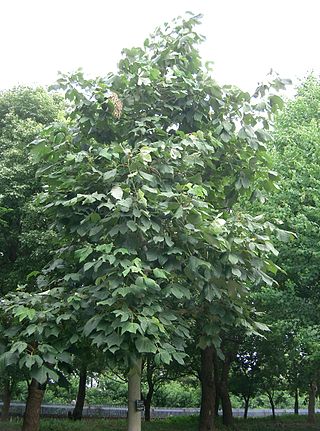
Firmiana simplex, commonly known as the Chinese parasol tree, Chinese parasoltree, or wutong, is an ornamental plant of tree size assigned to the family Malvaceae that was formerly in the family Sterculiaceae in the order Malvales, and is native to Asia. It grows up to 16 m (52 ft) tall.

Agastache rugosa, also known as wrinkled giant hyssop, Korean mint, purple giant hyssop, Indian mint and Chinese patchouli is an aromatic herb in the mint family, native to East Asia.
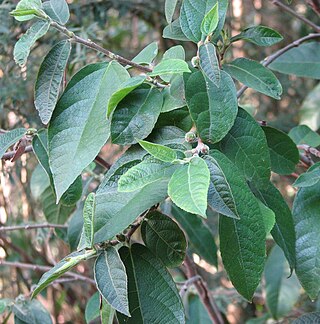
Ficus coronata, commonly known as the sandpaper fig or creek sandpaper fig, is a cauliflorous species of fig tree, native to Australia. It is found along the east coast from Mackay in Central Queensland, through New South Wales and just into Victoria near Mallacoota. It grows along river banks and gullies in rainforest and open forest. Its common name is derived from its rough sandpapery leaves, which it shares with the other sandpaper figs.
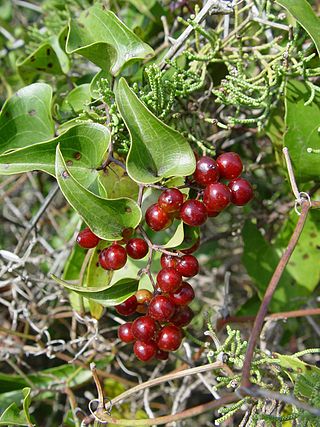
Smilax aspera, with common names common smilax, rough bindweed, sarsaparille, and Mediterranean smilax, is a species of flowering vine in the greenbriar family.
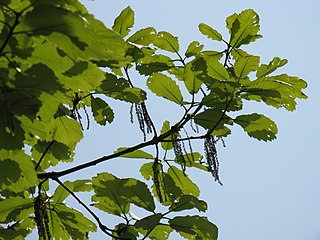
Quercus aliena, the galcham oak or oriental white oak, is a species of oak in the family Fagaceae, in the white oak section Quercus.




















